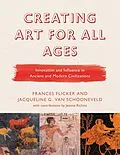This book is an interdisciplinary guide to connect art lessons with core curriculum. Social studies, language arts, math, and/or science are supported in every unit. It is an ideal source for elementary and middle school teachers to enrich their curriculum. It is an invaluable tool for art teachers to provide an interdisciplinary art curriculum that connects 21st Century Skills and National Standards. Problem solving, cooperative learning, and inquiry-based experiences are explored in every lesson.
Autorentext
Frances Flicker is a writer, artist, and teacher of art and humanities.
Jacqueline G. Van Schooneveld is a professor of teacher education.
Inhalt
Acknowledgments
Book Overview
Unit 1: Prehistoric Times and Civilizations: And the Journey Begins…
>Lesson 6: Venus of Willendorf, the First Sculpture, It Started with a Rock
Chapter 2: Sumerian Clay Statues: Dedicated to the One I Love
Lesson 1: Storytelling and Introduction, Can I Make a Statue Too?
Lesson 2: Activity "20 Squares" Board Game
Lesson 3: The Standard of Ur, Exploring Contradictions and Conflicts in Society
Lesson 4: Making the Artwork, Clay Votive Statue
Lesson 5: The Epic of Gilgamesh Explored
Chapter 3: Flower Design: Hanging Gardens of Babylon Lesson 1: Storytelling and IntroductionLesson 2: Preserve in PlasterLesson 3: Botanical Art: Making a Botanical Illustration, Art Meets ScienceLesson 4: Hanging Gardens Mixed Media CollageUnit 2: Egyptian Art and Civilization: Protection and Preservation
Chapter 4: What's in a Name? Lucky Charms: Creating a Cartouche and Making an Amulet Lesson 1: Storytelling and Introduction, "Cracking the Code"Lesson 2: Group Game: Code, Code, Crack and CreateLesson 3: Making Your Own CartoucheLesson 4: Discovering AmuletsLesson 5: Getting Personal with Pyramids, Making a Paper Pyramid SculptureChapter 5: Pots for Prosperity: Making Canopic JarsLesson 1: Storytelling and Introduction, You Saw What at the Museum?Lesson 2: Creating the Clay Canopic JarLesson 3: Canopic Jars Made from Recyclable MaterialsChapter 6: A Picture is Worth a Thousand Words: Creating a Narrative PaintingLesson 1: Observations, Storytelling, "I Dig Archaeology" and a Creative ActivityLesson 2: "A Picture is Worth a Thousand Words," Making a Narrative PaintingLesson 3: It's All in Your Hat, Making a Hat CollageUnit 3: Greek Art and Civilization: Creating a LegacyChapter 7: Masters of Pottery: Making a Greek Vase
Lesson 1: Storytelling, A John Keats's Inspired Tale of a Grecian Pot
Lesson 2: Making Pottery Inspired by the Ancient Greeks Chapter 8: Pillars of Greek Architecture: Pillars of Greece and Piet MondrianLesson 1: Storytelling, The Contest of Athena and PoseidonLesson 2: Making a Greek Architectural Watercolor with a Trace of Piet MondrianChapter 9: Masks of Mythology and Theater: Masks, Myths and Magic
Lesson 1: Storytelling, "Pygmalion Again and Again"
Lesson 2: Olympic Games, Role Playing "Let's Make a Game of It"
Lesson 3: Mask Making
Appendix A: Handouts for Chapters 1-9
Appendix B: Foundation Lessons and Technical Reference Sheets
Lesson 1: Concepts in Arts and Principles of Design
Lesson 2: Exploring Color and Creating a Color Wheel
Lesson 3: Designing with Texture
Lesson 4: Basics for Graphite Pencil Drawing
Lesson 5: Basics for Colored Pencil Drawing
Lesson 6: Basics for Charcoal Drawing
Lesson 7: Basics on Pastels (Hard and Soft Pastels)
Lesson 8: Basics on Oil Pastels
Lesson 9: Basics on Colored Makers
Lesson 10: Acrylic and Tempera Painting
Lesson 11: Basics on Watercolor Painting (Transparent Painting Medium)
Lesson 12: Building Blocks of Shapes
Lesson 13: Basics on Mixed Media and Collage
Lesson 14: Basics on Clay Hand Building Appendix C: Handouts for Foundation Lessons and Technical Reference Sheets Appendix D: FiguresWorks CitedAbout the AuthorsAbout the Contributor
